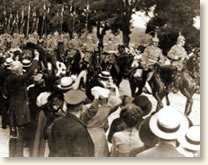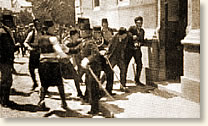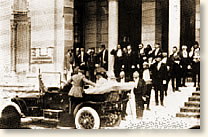Two bullets fired on a Sarajevo street on a sunny June morning in 1914 set in motion a series of events that shaped the world we live in today. World War One, World War Two, the Cold War and its conclusion all trace their origins to the gunshots that interrupted that summer day.
The victims, Archduke Franz Ferdinand - heir to the throne of the Austro-Hungarian Empire, and  his wife Sophie, were in the Bosnian city in conjunction with Austrian troop exercises nearby. The couple was returning from an official visit to City Hall. The assassin, 19-year-old Gavrilo Princip burned with the fire of Slavic nationalism. He envisioned the death of the Archduke as the key that would unlock the shackles binding his people to the Austro-Hungarian Empire.
his wife Sophie, were in the Bosnian city in conjunction with Austrian troop exercises nearby. The couple was returning from an official visit to City Hall. The assassin, 19-year-old Gavrilo Princip burned with the fire of Slavic nationalism. He envisioned the death of the Archduke as the key that would unlock the shackles binding his people to the Austro-Hungarian Empire.
A third party, Serbia, figured prominently in the plot. Independent Serbia provided the guns, ammunition and training that made the assassination possible.
The Balkan Region of Europe entered the twentieth century much as she left it: a caldron of seething political intrigue needing only the slightest increase of heat to boil over into open conflict. The shots that day in Sarajevo pushed the caldron to the boiling point and beyond.
A Royal Murder
Seven conspirators joined the crowd lining the Archduke's route to City Hall. Each took a different position, ready to attack the royal car if the opportunity presented itself. The six-car procession approached one conspirator, Gabrinovic (or Cabrinovic), who threw his bomb only to see it bounce off the Archduke's car and explode near the following car. Unhurt, the Archduke and his wife sped to the reception at City Hall. The ceremonies finished, the Royal procession amazingly retraced its steps bringing the Archduke into the range of the leader of the conspiracy, Gavrilo Princip. More amazingly, the royal car stopped right in front of Princip providing him the opportunity to fire two shots. Both bullets hit home. Borijove Jevtic, one of the conspirators gave this eyewitness account:
"When Francis Ferdinand and his retinue drove from the station they were allowed to pass the first two conspirators. The motor cars were driving too fast to make an attempt feasible and in the crowd were many Serbians; throwing a grenade would have killed many innocent people. When the car passed Gabrinovic, the compositor, he threw his grenade. It hit the side of the car, but Francis Ferdinand with presence of mind threw himself back and was uninjured. Several officers riding in his attendance were injured. The cars sped to the Town Hall and the rest of the conspirators did not interfere with them. After the reception in the Town Hall General Potiorek, the Austrian Commander, pleaded with Francis Ferdinand to leave the city, as it was seething with rebellion. The Archduke was persuaded to drive the shortest way out of the city and to go quickly. As the car came abreast he stepped forward from the curb, drew his automatic pistol from his coat and fired two shots. The first struck the wife of the Archduke, the Archduchess Sofia, in the abdomen. She was an expectant mother. She died instantly. The second bullet struck the Archduke close to the heart. He uttered only one word, 'Sofia' -- a call to his stricken wife. Then his head fell back and he collapsed. He died almost instantly. The officers seized Princip. They beat him over the head with the flat of their swords. They knocked him down, they kicked him, scraped the skin from his neck with the edges of their swords, tortured him, all but killed him." The road to the maneuvers was shaped like the letter V, making a sharp turn at the bridge over the River Nilgacka [Miljacka]. Francis Ferdinand's car could go fast enough until it reached this spot but here it was forced to slow down for the turn. Here Princip had taken his stand.
The road to the maneuvers was shaped like the letter V, making a sharp turn at the bridge over the River Nilgacka [Miljacka]. Francis Ferdinand's car could go fast enough until it reached this spot but here it was forced to slow down for the turn. Here Princip had taken his stand.
Another Perspective
Count Franz von Harrach rode on the running board of the royal car serving as a bodyguard for the Archduke. His account begins immediately after Princip fires his two shots: "As the car quickly reversed, a thin stream of blood spurted from His Highness's mouth onto my right check. As I was pulling out my handkerchief to wipe the blood away from his mouth, the I had no idea that she too was hit and thought she had simply fainted with fright. Then I heard His Imperial Highness say, 'Sopherl, Sopherl, don't die. Stay alive for the children!' At that, I seized the Archduke by the collar of his uniform, to stop his head dropping forward and asked him if he was in great pain. He answered me quite distinctly, 'It's nothing!' His face began to twist somewhat but he went on repeating, six or seven times, ever more faintly as he gradually lost consciousness, 'It's nothing!' Then, after a short pause, there was a violent choking sound caused by the bleeding. It was stopped as we reached the Konak." Duchess cried out to him, 'In Heaven's name, what has happened to you?' At that she slid off the seat and lay on the floor of the car, with her face between his knees.
Duchess cried out to him, 'In Heaven's name, what has happened to you?' At that she slid off the seat and lay on the floor of the car, with her face between his knees.
References:
Brook-Shepard, Gordon, Archduke of Sarajevo (1984); Dedijer, Vladimir, The Road To Sarajevo (1966); Morton, Frederick, Thunder At Twilight (1989).
How To Cite This Article:
"Assassination of Archduke Ferdinand, 1914," EyeWitness to History, www.eyewitnesstohistory.com (1998).

No hay comentarios:
Publicar un comentario